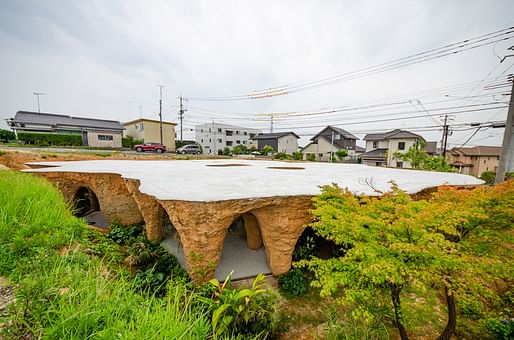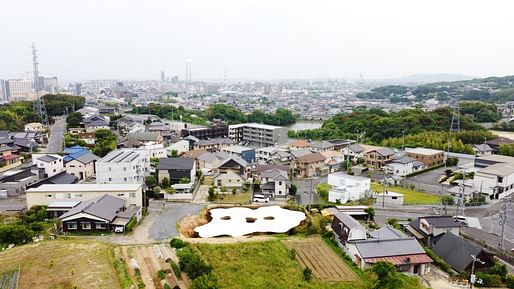
Junya Ishigami + Associates has completed a residence and restaurant for a French restauranter in the city of Ube, Japan. Asked by the client for a space that "has to look as if it has been there and will continue to be there for the longest time," Ishigami responded with a cave-like structure punctured by three courtyards.
The scheme’s construction saw the site excavated to shape an inverse volume of the final design. Concrete was then poured in situ and the surrounding earth excavated further to reveal the final form. Finally, glazing was fixed to external threshold arches to form interior spaces.

"When the structure was excavated after concrete solidification, it was caked with mud," Ishagimi recalls in a reflection for the Japanese magazine GA Houses translated by Fraze Craze. "With the range in geology, the nature and appearance of the soil differed from place to place. We originally planned to wash away the dirt to reveal a gray concrete structure. However, we were impressed by how it looked with soil that we decided to leave it as it is. It was then that we sensed the atmosphere of a cave and decided to redesign the building with a new image."
The internal layout sees a restaurant in the north area of the building, and the restaurant owner’s residence to the south, with both spaces linked by three internal courtyards.
"He was longing for something that is both a house and a restaurant, something he could pass on to his children and grandchildren," Ishigami explains.
"Now, he invites guests to the restaurant as he would invite friends to his house, and with someone special, he would let them into the living room or even stay overnight," the architect continues. "When the restaurant is closed, the hall serves as a place for the family to spend time or for the children to study."
The unorthodox construction approach resulted in a "flipped" design process where discrepancies between design drawings and the excavated structure revealed new spaces that the team had not anticipated. These feedback loops between design and reality saw the team reconsider the installation of components while construction progressed, including where to place glass partitions, how to simplify plumbing routes, and decisions on the arrangement and size of furniture.
"Accepting uncertainties, the concrete mass will gradually be transformed into architecture through cut-and-try," Ishigami concludes. "The owner will start a life here, run a restaurant, and continue to renew this place."

3 Comments
this is pretty damn cool, but I’m sure a structural engineer somewhere got a few grey hairs.
Pretty sure he works with the same structural engineer on all his projects - Ishigami has attributed the success of these works to the engineer who somehow figured out how to build his ideas. More of a collaboration between the two than the usual A-E relationship.
cave architecture
https://inhabitat.com/180000-y...
Block this user
Are you sure you want to block this user and hide all related comments throughout the site?
Archinect
This is your first comment on Archinect. Your comment will be visible once approved.